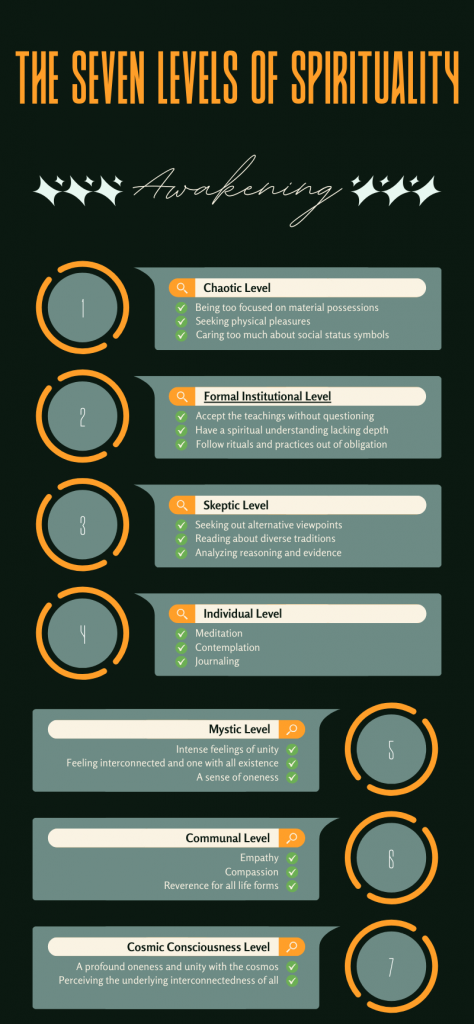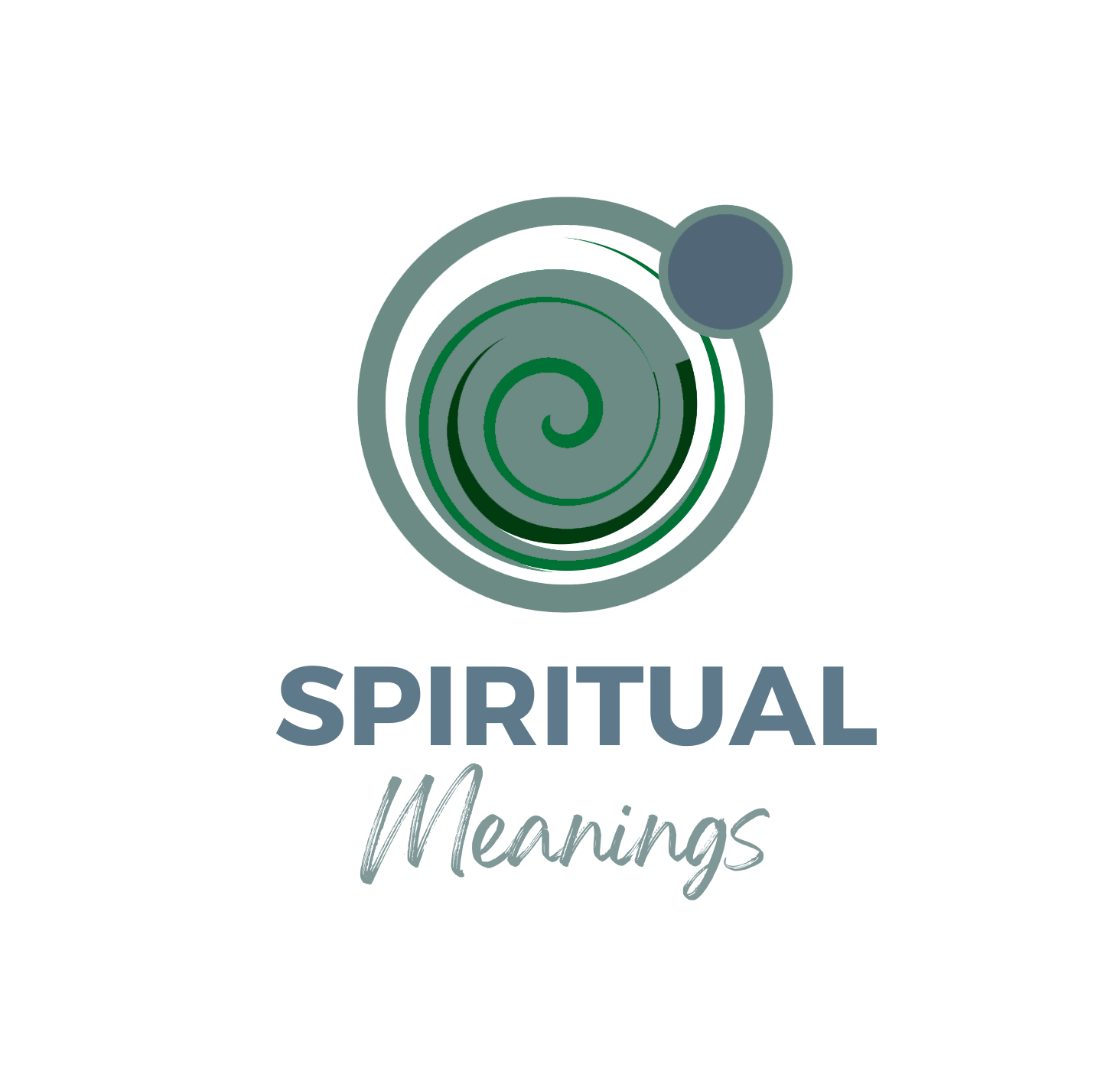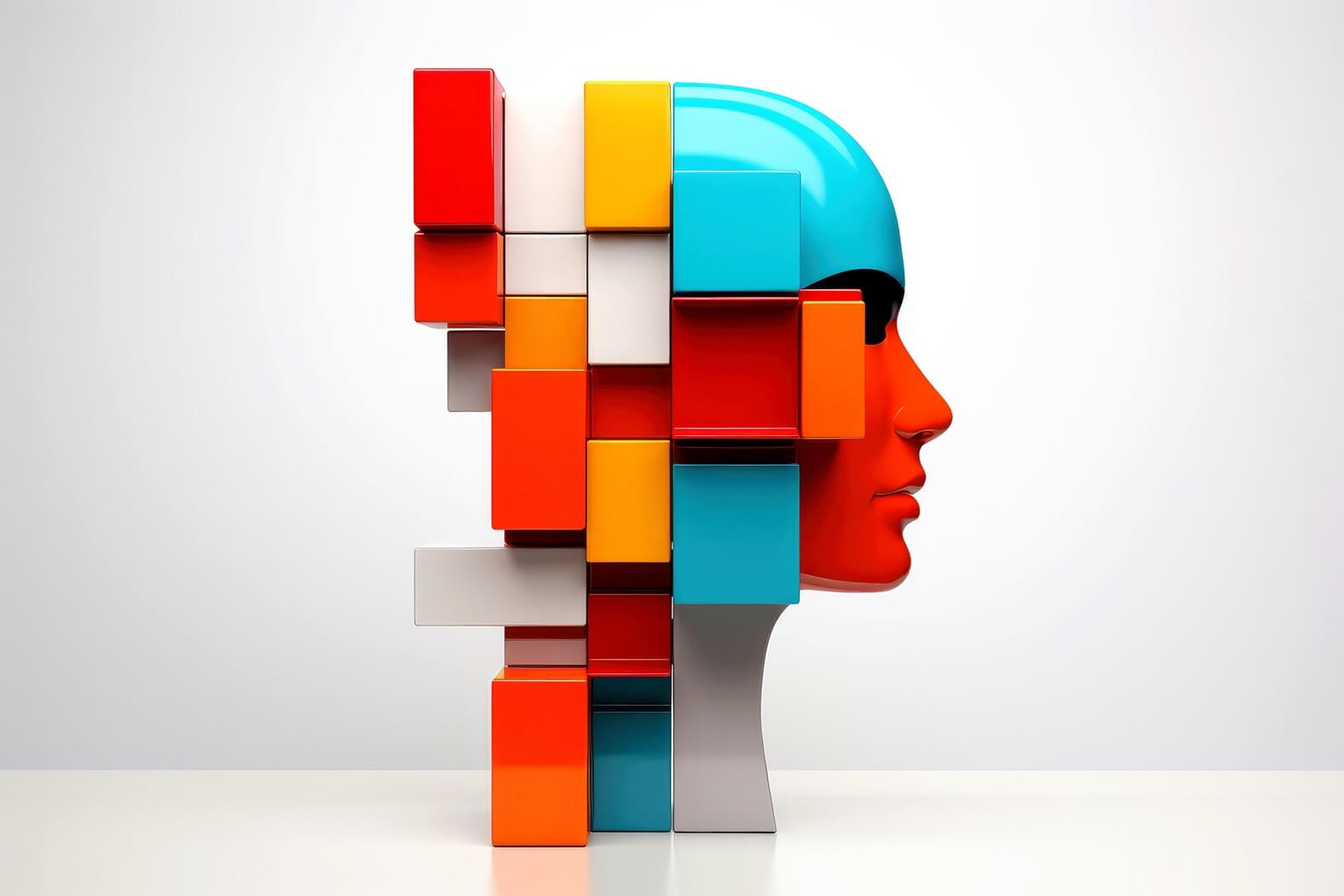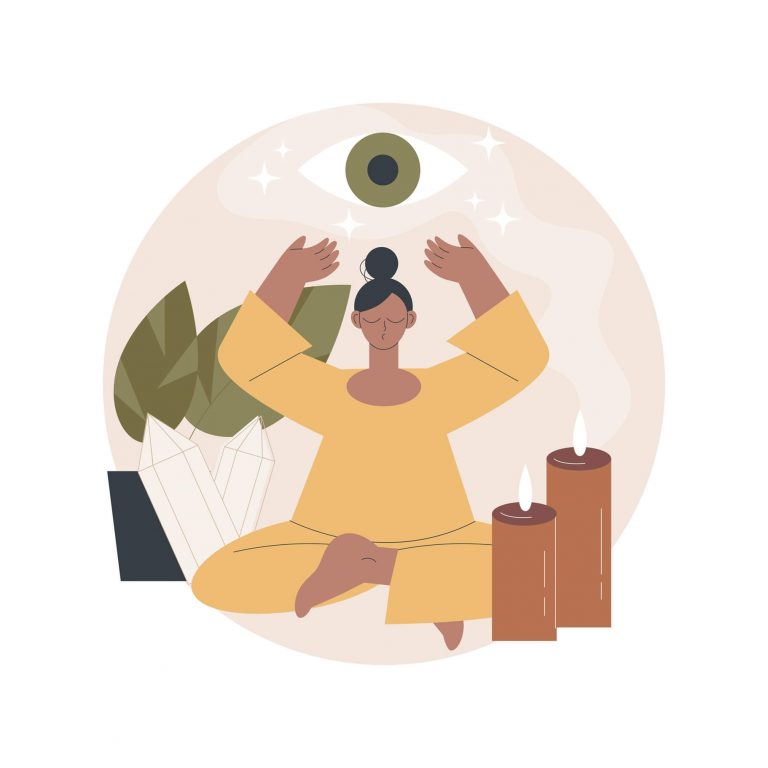Last Updated on April 2024
In this article we decided to do something differently, and make an extraordinary journey beyond the normal world. SpiralSpiritual will try to explore higher levels of awareness, where so-called enlightenment can be found, to reach a deeper connection with the universe and your true inner self.
According to Dr. M. Scott Peck’s book “The Road Less Traveled“, the seven levels of spirituality are: 1) Chaotic – lacking spiritual awareness, 2) Formal Institutional – following organized religion without deeper understanding, 3) Skeptic – questioning beliefs, 4) Individual – developing personal spiritual beliefs, 5) Mystic – having direct experiences of the divine, 6) Communal – embracing unity with all beings, 7) Cosmic Consciousness – complete oneness with the universe.
In this article we will try to outline the seven progressive stages of spiritual growth and development according to wisdom traditions. Our goal is to create a clear roadmap for understanding the journey of spiritual unfolding.
1. Chaotic Level
The Chaotic Level is the first of the seven levels of spirituality. At this level, people don’t have much spiritual awareness or interest. Their lives are mostly about satisfying basic needs and wants, without caring much about higher principles or deeper meanings. The chaotic level is defined by a self-centered perspective where the world is seen only as a way to fulfill one’s own desires.

People at this level tend to act in an undisciplined and disorganized way. They are driven by sudden urges, addictions, and the desire for immediate pleasure. They may do harmful or self-destructive things without thinking about the consequences. There is a general lack of self-awareness, self-reflection, or a sense of personal responsibility. Some of the most common traits of this level include:
- Being too focused on material possessions
- Seeking physical pleasures
- Caring too much about social status symbols
Individuals at this stage may think that wealth, power, and sensory enjoyment are the most important things in life. They may feel entitled, lack empathy for others, and ignore ethical or moral considerations.
The chaotic level can also represent a state of spiritual ignorance and disconnection from any deeper meaning or purpose. It’s a condition of being trapped within one’s own ego, desires, and immediate circumstances, without the awareness or interest to seek a more profound understanding of existence or transcendent reality.
2. Formal Institutional Level
The Formal Institutional Level is the second of the seven levels of spirituality. At this level, people have developed a basic understanding of spiritual concepts and principles, mainly through their involvement with organized religious or philosophical institutions.

In a contrast to previous level, people at the Formal Institutional Level typically follow the teachings, rituals, and practices dictated by their chosen religious or spiritual tradition. They find meaning and purpose in being part of these established institutions, which provide a structured way to understand the divine or transcendent aspects of existence. People at formal institutional level are often:
- Accept the teachings and beliefs passively, without questioning
- Have a superficial spiritual understanding, lacking personal depth or direct experience
- Follow rituals and practices out of obligation, tradition, or social pressure, rather than genuine motivation or connection
The Formal Institutional Level represents a stage where individuals have taken the first step beyond the Chaotic Level by acknowledging the existence of a higher reality or spiritual dimension. At this level, people may still have doubts, questions, or feel disconnected from the spiritual teachings they’ve been exposed to.
3. Skeptic Level
The Skeptic Level is the third of seven levels of spirituality. At this level, people start to seriously question and challenge the beliefs, teachings, and institutions that have shaped their spiritual understanding up until now.

The Skeptic Level is marked by a strong desire to learn and a wish to carefully examine claims that lack proof. People at this level may feel disappointed or unsatisfied with the religious or philosophical explanations they have encountered before, leading them to adopt a more skeptical and inquisitive mindset.
During this stage, people may go through a process of doubting and investigating. They may closely examine the beliefs and assumptions they have inherited. They may look for different perspectives, explore various philosophical or spiritual traditions, and critically analyze the reasoning and evidence behind different belief systems. Some activities they may engage in include:
- Seeking out alternative viewpoints
- Reading about diverse traditions
- Analyzing reasoning and evidence
The Skeptic Level often involves a period of breaking down previous spiritual or religious frameworks. People may dismantle and reject aspects they find unconvincing or lacking substance. This can be unsettling, as it means letting go of long-held beliefs and facing uncertainty.
4. Individual Level
The Individual Level is the fourth of seven levels of spirituality. At this level, people move past the skepticism and questioning of the previous level. They start to create their own personalized understanding of spiritual principles and truths.
The Individual Level is marked by a strong sense of self-awareness. People are committed to exploring spirituality through their own personal experiences, self-reflection, and direct exploration. They recognize the limitations of relying solely on external authorities or inherited beliefs. Instead, they seek to develop an individualized and authentic connection with the spiritual dimension.

During this level, people may engage in various practices aimed at personal growth, self-discovery, and inner exploration. This can involve activities such as:
- Meditation
- Contemplation
- Journaling
- Engaging with philosophical/spiritual texts in a personal way
The Individual Level often involves combining insights from various sources into a cohesive spiritual worldview. People may draw upon diverse traditions, philosophies, and personal experiences, weaving them into a unique tapestry reflecting their journey and evolving understanding.
At the same time, this level requires introspection and self-examination. People may confront their own biases, fears, and limitations as part of spiritual growth. This can be freeing yet challenging, as it means questioning beliefs – even self-constructed ones.
5. Mystic Level
The Mystic Level is the fifth of seven levels of spirituality. At this high level, people start to have deep and direct experiences with the divine, transcendent, or ultimate reality.
The Mystic Level involves a big shift in how people see things. The boundaries between the self and the larger cosmic or spiritual reality become less clear. People at this stage may experience mystical states of consciousness, such as:
- Intense feelings of unity
- Feeling interconnected and one with all existence
- A sense of oneness
These mystical experiences are difficult to explain using reason and go beyond the limits of language or conceptual understanding. They may show up as powerful feelings of awe, reverence, or ecstasy, along with a deep sense of profound insight or revelation. People at the Mystic Level may report experiences of profound peace, unconditional love, or a radically different perception of reality.

During this level, people may practice things that help facilitate these mystical states, such as advanced meditation techniques, contemplative prayer, or other spiritual exercises. The experiences themselves are considered direct encounters with the divine or ultimate truth, not just results of the techniques.
6. Communal Level
The Communal Level is the sixth stage of the seven levels of spirituality. At this level, people go beyond their individual spiritual experiences and deeply feel interconnected and united with all beings.
The Communal Level is marked by a strong recognition that there is a fundamental oneness underlying all existence. People at this stage experience profound:
- Empathy
- Compassion
- Reverence for all life forms
They recognize the inherent divinity present in every being.
This level often shows up as a strong desire to serve and contribute to the greater good of humanity and the planet. People may feel called to actively engage in acts of service, social activism, or environmental stewardship. This is driven by a deep sense of responsibility and care for the well-being of all.

At the Communal Level, the boundaries between the self and others dissolve, leading to a profound sense of unity and belonging within the larger web of existence. This experience of interconnectedness extends beyond just humans, encompassing reverence for all life forms, from the smallest microorganisms to vast ecosystems.
People at this level may practice things that foster this sense of unity, such as community-based spiritual practices, participating in collective rituals or ceremonies, or actively working towards social or environmental justice causes.
The Communal Level represents a profound shift in perspective. The individual’s spiritual journey expands beyond personal growth to encompass a deep sense of responsibility and care for the collective well-being of all beings.
7. Cosmic Consciousness Level
The Cosmic Consciousness Level represents the highest of the seven levels of spirituality. At this ultimate stage, people experience complete and unbroken union with the divine, transcendent reality that exists in all of existence.

The Cosmic Consciousness Level is marked by a profound and sustained state of non-dual awareness. The boundaries between the self and the ultimate reality dissolve entirely. People at this level experience:
- A profound oneness and unity with the cosmos
- Perceiving the underlying interconnectedness of all phenomena
In this state, the limits of the individual ego and separate self-identity are transcended. This gives way to a direct experience of the infinite, eternal, and all-encompassing nature of existence. The individual consciousness merges with the cosmic consciousness, leading to profound liberation, freedom, and transcendence of all dualities and limitations.
At the Cosmic Consciousness Level, people may report experiences of boundless love, bliss, and a deep sense of belonging to all of creation. They perceive the inherent divinity in all beings and phenomena, recognizing the sacred nature of existence itself.
This level is often described as enlightenment, moksha, or the ultimate realization of the true nature of reality. It represents the culmination of the spiritual journey, where the individual merges with the absolute, transcending boundaries and limitations imposed by the ego, attachments, and the illusion of separateness.
To Sums Up
So, the seven levels are like a map. This map helps people understand their spiritual potential. The experiences may be different for different people. But the levels show the way to connect deeply with the divine reality.
- At the lower levels, people are not very aware of spiritual things. As they go higher, they start to feel more connected to all existence. They develop qualities like empathy and compassion for all beings.
- At the highest level, cosmic consciousness, people feel completely united with the divine. They go beyond the individual self and merge with the oneness of everything.
This journey through the levels invites people to change and grow in a personal way. It also helps them understand the sacred nature of life deeply.



